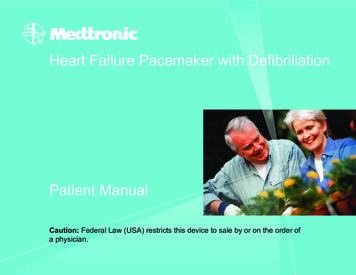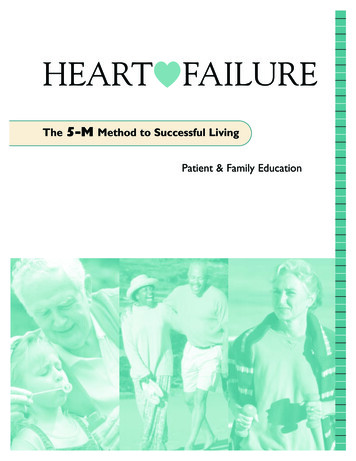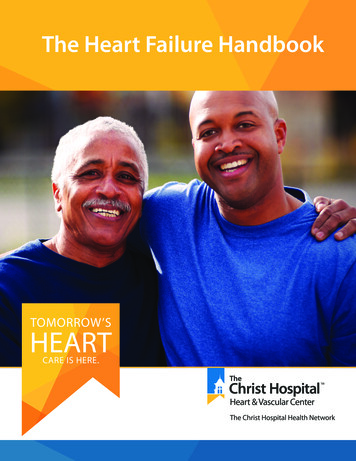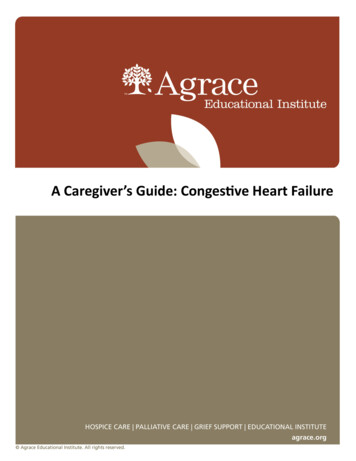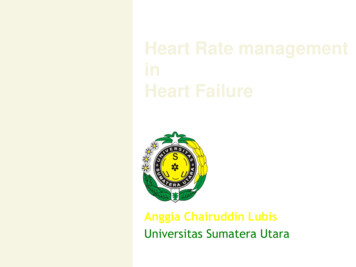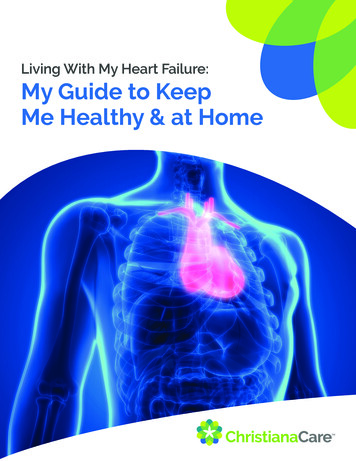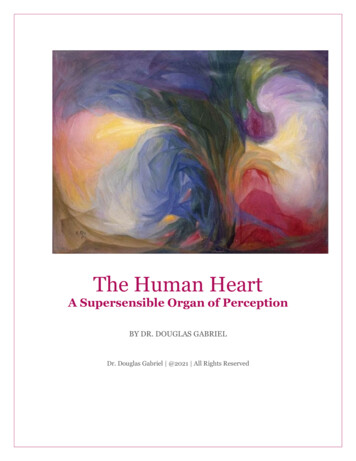
Transcription
The Human HeartA Supersensible Organ of PerceptionBY DR. DOUGLAS GABRIELDr. Douglas Gabriel @2021 All Rights Reserved
Table of ContentsChapter 1: The World Changes When Our Hearts DoChapter 2: Physiological Aspects of the Human HeartHeart Intelligence . 24Heart/Brain Coherence . 25Secrets of the Heart. 26The Electrical Axis of the Heart . 30The Ideal Heart Axis . 32The Heart Sac – Fifth Chamber of the Heart . 33The Auricles of the Atria – the Sixth & Seventh Chambers of the Heart . 35The Vagus Nerve . 37Heart Rate Variability .40PAGE 1
Frequency Rate of the Human Heart . 42The Heart’s “Pacemaker” - Atriosino Node. 43The Anatomical “Box Around the Heart” .46The Four Parts of the Mediastinum .48Blood Types .48Blood Types and Nutrition . 50Chapter 3: Three Fields of ForceThe System of Chakras. 54Heart Chakra . 54Head Chakra . 57Lower Chakras - Metabolic System . 58A Cup of Golden Light . 59Plasma Generators in the Human Body . 61PAGE 2
Chapter 4: Great Thoughts About the HeartThe Heart, Sue Pegler .64The Art of Perceiving from the Heart, by Paul Salkovskis . 65Heart Lectures, Ehrenfried Pfeiffer . 66Clairvoyance and Consciousness, The Tao Impulse in Evolution, by T. H. Myer . 69On the Human Heart and its Mission, by John Barnwell . 69The Heart as an Organ of Perception, by Charles B. Parselle. 70The Harmony of the Human Body, by Armin Husemann .71The Heart-Mind Matrix, by Joseph Chilton Pearce. 72The Mystery of the Blood, by James Dyson . 72The Dynamic Heart and Circulation, by Craig Holdrege . 73Enlivening the Chakra of the Heart, by Florin Lowndes . 74The Human Organs, by Walter Holtzapfel . 74PAGE 3
Warmth and the Heart, The Human Ego Organization, Heinz-Hartmut Vogel. 75The Bleeding Wound of King Amfortas, Karal Jan Tusenius . 76Polarity of Center and Periphery in the Circulatory System, by HeinrichBrettshneider . 77Human Heart Cosmic Heart, by Thomas Cowan. 78Healing Sounds: Fundamentals of Chirophonetics by Alfred Baur. 81Functional Morphology, by Johannes Rohen . 83Life Processes in the Blood Organization, Hemsworth Brüder von Laue .84Formation of a New Etheric Heart Organ in the Light of the Michaelic MysteryCulture by Ruth Haertl, Michaelmas, 2000 . 91Chapter 5: Rudolf Steiner on the Human HeartThe Heart as a Supersensible Organ of Perception . 99Course for Young Doctors, January, 1924, GA 316 . 99Rudolf Steiner, source unknown. 100PAGE 4
Spiritual Science and Medicine, Lecture II, March 22, 1920, GA 312 . 100The Heart is Not a Pump . 101Seven Lectures to Workmen, Lecture 3, June 6, 1923, GA 350 . 101Theosophy of the Rosicrucians, Lecture 13, London, GA 99. 101Esoteric Development, 1923, GA 84 . 101Spiritual Science and Medicine, Lecture VIII, March 27, 1920, GA 312 .102The Effects of Esoteric Development, March, 1913, GA 145 .102From Mammoths to Mediums, June 6 , 1923, GA 350 . 104Therapeutic Insights: Earthly and Cosmic Laws, Lecture IV, July 2, 1921, GA 205 . 106Mysteries of the Human Heart .107The Influence of Spiritual Beings Upon Man, Lecture 3, GA 137 .107Color, Lecture 3, GA 228. 108The Workmen’s Lectures, 1922, GA 347. 108PAGE 5
Psychoanalysis in the Light of Anthroposophy, Lecture 6, London, GA 205 . 109From the Contents of Esoteric Classes, Berlin, February, 26, 1908, GA 266 . 109Health and Illness, The Relationship Between the Breathing and the Circulation ofthe Blood, December 23, 1922, GA 348 . 109Philosophy, Cosmology, and Religion, September 1922, GA 215. 110Spiritual Science and Medicine, 1920, GA 312 . 110Wisdom of Man, of the Soul, and of the Spirit, Lecture 3, October 26, 1909, GA 115. 110From Limestone to Lucifer Answers to Questions, May 7, 1923, GA 349 . 111Anthroposophical Approach to Medicine, Lecture IV, October 28, 1922, GA 314 . 112Man as Symphony of the Creative Word, Lecture III, 21st October, 1923 . 112From the Contents of Esoteric Classes, Berlin, March 14, 1908, GA 266 . 114Initiate Consciousness Truth and Error in Spiritual Research, August 11, 1924, GA243 . 115From Comets to Cocaine Answers to Question, January 8, 1923, GA 348 . 116PAGE 6
From Sunspots to Strawberries Answers to Question, July 31, 1924, GA 354 . 116The Heart is the Temple of the Human Spirit . 117The Mystery of Golgotha, 29 July, 1906, GA 97 . 117Rudolf Steiner from his sick bed in 1924 . 118How the Spiritual World Projects in Physical Existence, May 5, 1913, Paris, GA 150118An Occult Physiology, March, 1911, GA 128. 119Therapeutic Insights: Earthly and Cosmic Laws, Dornach, July 2, 1921, GA 205. 119Supersensible Man, November 1923, GA 231 .120Foundations of Esoterism, September 1905, GA 93.120Man: Hieroglyph of the Universe, April, 1920, GA 201 .120Macrocosm and Microcosm, March 1910, GA 119 . 121Supersensible Man, Lecture IV, November 17, 1923, GA 231 . 121Occult Significance of Blood, Berlin, October 25, 1906, GA 55 . 122PAGE 7
An Occult Physiology, The Blood as Manifestation and Instrument of the HumanEgo, Lecture 6, March 26, 1911 . 123The Etheric Heart and Blood .124Curative Education, June, 1924, GA 317.124Pastoral Medicine, September 1924, GA 318 . 125The Human Soul in Relation to World Evolution, Lecture VI, May 26, 1922, GA 212. 125The Etherization of the Blood, Basle, October 1, 1911, GA 130 . 127The Human Heart, Dornach, May 26, 1922, GA 212 . 129The Human Soul in Relation to World Evolution, Lecture VI, Dornach, 26th May1922 . 132Heart Thinking as Living Thoughts .138Macrocosm and Microcosm, Organs of Spiritual Perception, Thinking of the Heart,March 29, 1910, GA 119 .138Ancient Myths: Their Meaning and Connection with Evolution, 12th January 1918 139PAGE 8
The Human Soul in Relation to World Evolution, Lecture V, Dornach, 7th May 1922.142Verse by Rudolf Steiner . 146Verse for Ita Wegman, February 27, 1925 .147Verses and Meditations, by Rudolf Steiner . 148Chapter 6: Dodecahedron UniverseSupersensible Knowledge: Blood is a Very Special Fluid, Rudolf Steiner, 25 October,1906 .150Toward the 21st Century - Doing the Good, The Stone of Love, Bernard Lievegoed. 151The Universe as a Phi-based Dodecahedron, by Gary Meisner, May 1, 2012 . 151Chapter 7: Historical Review of the Centrality of theHeartAncient Indian Wisdom of the Heart .158The Para-pravesika by Ksemaraja .159PAGE 9
Chandogya Upanishad (8.1.1-4) .159Brihadaranyaka Upanishad (4.1.7) .159Brihadaranyaka Upanishad (5.6.1) . 160Svetasvatara Upanishad (4.17). 160Katha Upanishad (6.16-17) . 160Taittiriya Upanishad (1.6.1). 160Maitri Upanishad (6.22) . 161Mahanarayanopanisad Upanishad (13.6-12) . 161Brihadaranyaka Upanisad (4.2.3) . 161Khandogya-Upanishad . 162The Rig Veda . 162The Triadic Heart of Siva, by Abhinavagupta .165Vimarsini, by Abhinavagupta. 169PAGE 10
Heart Research in Egypt .170The Heart According to the Greeks . 171From: Aristotle’s On the Generation of Animals . 172From: De Anima, Aristotle . 173Alexandrian Period . 173Roman Period .174Byzantine Period . 175Summa Theologica, Thomas Aquinas . 175Summa Contra Gentiles, Thomas Aquinas. 176Islamic Period . 176The “Eye of the Heart” in Sufi Tradition. 177European Period .178The Christian Desert Fathers . 179PAGE 11
Microcosm Heart, Paracelsus . 179The Perfect Way, by Anna Bonus Kingsford . 180G. R. S. Mead’s Theosophical View . 180Isis Unveiled, Helena P. Blavatsky . 180A Sleep of Prisoners, by Christopher Fry . 181Chapter 8: Eastern Wisdom of the Etheric HeartThe Endless or Glorious Knot . 184The Box Around the Wish Fulfilling Stone .187The Wishing Fulfilling Tree – Cintamani Jewel . 188Heart: Chinese Fire-energy . 190Traditional Pulse Diagnosis . 191The Heart Channel Pathway via Acupuncture Points . 192Eternal Para-Bindu Drops .193PAGE 12
The Drum of Shiva . 194Conclusion. 196BIBLIOGRAPHY & REFERENCES . 199Videos on The Human Heart .201Two Articles on the Heart . 202The Heart Revolution Site . 202Branco Furst’s Heart Theory . 202Dr. Thomas Cowen Youtube - The Heart is Not a Pump . 203PAGE 13
The World Changes When Our Hearts Do“Go to your bosom; knock there, and ask your heart what it doth know ”William ShakespeareAny undertaking to describe the human heart in all its glory is bound to be limited in itsscope because the heart has been evolving along with humanity and will continue to doso into the future as its nature, over time, is unlimited. Any comprehensive expose on thehuman heart would have to go back in time to witness the embryological development ofthe heart and project into the future an attempt to describe what the heart will become.Even with a comprehensive historical perspective on what great thinkers have“discovered” about the heart, we cannot wrap our arms around this central core of thehuman being. The ideas of what the heart will become has been speculated upon bydoctors and philosophers with mysterious stories of the future fifth, sixth, and seventhchambers of the human heart yet to be discovered.These speculations shed light on a few parts of the unfolding heart mystery. Indeed, theancients focused on the heart as the seat of human consciousness and speculatedthat the involuntary muscle of the heart will become a voluntary muscle that willsomeday be completely controlled by human will power that is charged with moralforces. Many philosophers say the voice of the heart is the moral conscience of theindividual, a type of super-organ that can perceive everything, both inner and outer.There is no limit to the power and majesty of the cardiovascular system working togetherwith respiration. As Christopher Fry tells us in his play, A Sleep of Prisoners: “Thehuman heart can go to the lengths of God.” In fact, spiritual scientists, old and new,agree that the heart is a sense organ that can listen to and understand the language of thedivine. Some would go so far as to claim that the human heart is the holy grail that is thetreasure found by the worthy knight who suffers the quest for the grail for the sake ofothers. Or as Walter J. Stein tells us in his book, The Nineth Century: “The Holy Grail isthe consummation of the heart’s desire, its root and blossoming . . . paradisical,transcending all earthly perfection.”PAGE 14
Throughout our presentation we will be seeking answers to many questions about theheart from the ancient Hindu Vedas to cutting edge modern research on heart ratevariability. Many misconceptions will be outlined in a timeline that reflects the evolutionof heart knowledge over the course of history. One of those gross errors in understandingthe heart and its function is the myth that the heart is a pump. But the true view of bloodcirculation is much more complicated and has only become accepted by cardiologists inrecent times. Dr. Rudolf Steiner’s teachings contend that: “The heart is not a pump; theheart is an organ of perception.” As a matter of fact, he believes that the heart is themost important organ of perception that can be trained to become a supersensible organof perception of both the outside world and the inside world of the human being. Theheart is the organ that can commune with the divine through a language of the spirit thatis unique to the heart.The mechanisms that develop this supersensible organ will be the major theme of thisessay. We intend to show that a thorough examination of the heart will unveil numerous“heart mysteries” that have been known since time immemorial, but little understood bymodern science. Even though, the most current heart research demonstrates that theancients, and spiritual scientists like Rudolf Steiner, had the story correct all along.Some of the mysteries that have come to light concerning the heart are leading doctorsand scientists to rethink and reimagine the profound centrality of the heart and itseffects on all aspects of human physiology and health. Some ideas from the past willsound somewhat unfounded or magical, but over time they have come to be the new viewthat is being adopted by main-stream science. A few of those heart mysteries are: The nature of the seven chambers of the heart The connection between heart and brain coherence The etherization of the blood through the “front spinal column” (vagus nerve) The importance of the axis of the heart in utero and as an adult The predictive capacities of heart rate variability to determine longevity and illness The electrical nature of the heart and its torus field of energy The nature of the human “I am” found in the heart The central focus of the human mind in the heart – not the headPAGE 15
The capacity to develop heart-thinking through warmed up thoughts The secret “box” in the heart that records karma from one life to another The role of the heart “chakra”, its nature and function The etherization of the blood and its ability to nourish the pineal and pituitary gland The development of morality through the supersensible organ of the heart The true shape of the heart in current times and its shape in the future Heart perception as an alchemical process involving salt/mercury/sulfur The mystery of the “jewel in the heart of the lotus” – the cintamani stone The mystery of the wish fulfilling tree – the world tree planted in Eden The awakening of the heart as the tool to define and control all perception The heart is created by two interpenetration vortices Perception is written into the blood There is a cognitive path of heart-perceptionThis list of heart mysteries is not exhaustive and many other hidden truths will comeforth as we look at the literature concerning the heart. We find many of these insightsand inspiration in every type of writing, from sacred texts to modern poetry. Everywherewe look, we will find aspects of the heart being described as the most profound center ofhuman consciousness, evolution, and love. The ancients often lumped the heart togetherwith other key components of human self-development by linguistics and association.The heart is clustered together with ideas about the hearth (seat of fire), the ear(hearing), the home, heaven, and mother. When you think about the heart, the mostimportant human thoughts also come to light. The seat of life and consciousness findtheir home in the heart as the throne of love that reflects the love of heaven on earth.The heart is the mystical source and crucible of love, the ‘august master binding of all.’As the Chaldean Oracles state: “Having mingled the spark of soul with two, with breathand mind divine, he added to them a third, pure love, the august master binding of all.”It is now time in human evolution to start thinking with the mind of the heart. Or as VanMorrison puts it in one of his lyrics: “If my heart could do my thinking, and my headbegin to feel, I would look upon the world anew, and know what’s truly real.” This poeticinjunction is the key mission of humanity as it develops moral (warmed-up) thinkinginstead of brain-bound, cold, dead thinking that leads to the void of materialism. ThePAGE 16
head is the past. The heart is the past, present and future where we learn to speak withthe divine and receive cosmic nourishment from the exchange of love between humansand the divine. Or as Meister Eckhart has told us: “God is born in the heart and the heartis born in God.”When hearts begin to feel, thinking can develop into living imaginative thinking that isbased in reality – not cold-hearted scientific materialism that leads to nihilistic despair.Living thoughts are born in warm-hearted thoughts that have a life of their own that isfired through and through by hierarchical beings who share those inspirations withhumans. Learning the language of the spirit is basically learning the language of themoral heart. Often this language of the heart is spoken in poetic language that canstretch the human imagination to “the lengths of God.” The great poet and writer,Fredrick von Hardenberg (Novalis) gives us the insight that: “The human heart is theuniversal field of beings. It is the field where all faculties of the mind - understanding,reasoning, imagination, and feelings, are integrated. Human beings can feel with theirheart using a language indicative of love.”Novalis also tells us that it is only the human heart that can satisfy this unquenchabledesire to commune with our higher nature that is found in the divine. He tells us:“Building worlds is not enough for the deeper urging mind; but a loving heart sates thestriving spirit.”Khalil Gibran agrees with Novalis that the heart is where the secrets of love are found:“All these things shall love do unto you that you may know the secrets of your heart, andin that knowledge become a fragment of life’s heart.” Or as Johann Wolfgang von Goetheput it: “What is uttered from the heart alone will win the heart of others to your own.”Goethe predicated the perception of the world upon the capacity of the individual’s heartcontent: “A man sees in the world what he carries in his heart.” Thus, the heart is the keyto perceiving the world either as heaven or hell, depending on what each person carriesin their heart. We see the world through the lens of the heart. It seems that to change ourview of the world, we simply need to change the content of our hearts. The great Sufipoet Kabir insinuates the same wisdom when he said: “Lift the veil that obscures theheart, and there you will find what you are looking for.”PAGE 17
We must learn to seek the answers about the world and our self inside the heart as thepoet Rainer Maria Rilke tells us: “The work of the eyes is done. Go now and do the heartwork on the images imprisoned within you. All the soarings of the mind begin in theblood.” This shows us that our conscious mind needs to realize that the depth of heartwisdom never ends. Rilke tells us in another passage: “Our heart always transcends us.Have patience with everything that remains unsolved in your heart. live in thequestion.”Poets have given us the ability to transcend brain-bound thinking with a few simplewords that open the heart to its truly divine nature. Whatever you consider the divine tobe, we find its source and end in the human heart. As the Sufi poet Rumi tells us: “Onlyfrom the heart can you touch the sky. Your heart knows the way. Run in that direction. Iflight is in your heart, you will find your way home.” So we begin and end in the heart,which sometimes is unfamiliar to the secular humanist who “believes” in modernmaterialistic science. Human consciousness transcends the five senses that modernscience is based upon. There are higher senses that reveal our divine nature found in thequiet beating of the heart.Rumi points to the source and finds it to be never ending. He gives us the injunction:“Why are you knocking at every door? Go, knock at the door of your own heart. Whoeverhas heart’s doors wide open, could see the sun itself in every atom. Surely there is awindow from heart to heart: they are not separate and far from each other. And now thetime has come to turn your heart into a temple of fire.” This temple of fire is the source offiery wisdom that connects us directly to our higher self and the divine self of theuniverse. Rumi gives us the formula in the following lines: “When you seek love with allyour heart you shall find its echo in the universe. When love for God has been doubled inyour heart, there is no doubt that God has love for you.”But modern poetry takes its lead from the wisdom of the ancients found in every sacredbook or text of the past. In ancient India, a profound understanding of the heart wasknown as a central principle of spiritual teachings that go back to the first writings ofhumanity. The heart was always given the highest praise and was placed on a throne thatwas unequal to anything but the divine beings themselves. In the Chandogya Upanishadwe are told: “As gre
The World Changes When Our Hearts Do “Go to your bosom; knock there, and ask your heart what it doth know ” William Shakespeare Any undertaking to describe the human heart in all its glory is bound to be limited in its scope because the heart has


